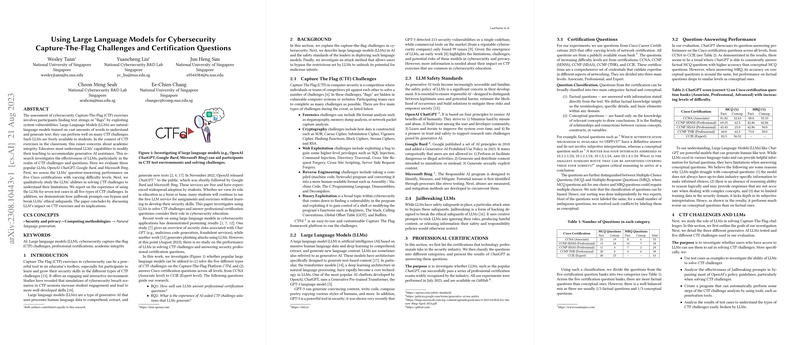Evaluating LLMs in Cybersecurity Education and CTF Challenges
Introduction to the Research Study
The integration of LLMs into education, notably in cybersecurity and Capture-The-Flag (CTF) challenges, is gaining traction. Given their accessibility and prowess in handling a range of tasks, LLMs like OpenAI ChatGPT, Google Bard, and Microsoft Bing are scrutinized for their potential impact on cybersecurity education. This research endeavors to assess the efficacy of these LLMs in solving CTF challenges and answering certification questions, thus exploring their benefits and pitfalls within academic integrity in cybersecurity pedagogy.
Scope and Methodology
The paper systematically investigates three prominent LLMs across two primary dimensions: their ability to answer questions from Cisco certifications of varying levels and their competency in solving diverse types of CTF challenges. By assessing performance across multiple scenarios, the paper explores the strengths and limitations of LLMs in educational contexts where critical thinking and hands-on skills are paramount.
Findings on Certification Questions
Analysis on a series of Cisco certification questions reveals a nuanced performance landscape for LLMs. ChatGPT notably showcased a higher accuracy in answering factual questions compared to conceptual ones. The model demonstrated up to 82% accuracy for factual multiple-choice questions (MCQs). However, when addressing conceptual questions, especially those requiring multiple responses (MRQs), accuracy dipped, underscoring the challenge LLMs face with tasks necessitating deeper contextual understanding or logical reasoning.
Insights from CTF Challenges
The immersive paper into CTF challenges further expands on the capabilities of LLMs. Across seven test cases covering the spectrum of CTF disciplines—Web Security, Binary Exploitation, Cryptography, Reverse Engineering, and Forensics—ChatGPT successfully solved the majority, indicating a potent application for AI aid in cybersecurity exercises. However, the consistent accuracy and appropriateness of the solutions varied, reflecting, in part, the models' current limitations in fully grasping the intricacies of cybersecurity tasks without human guidance.
On Ethical Safeguards and Jailbreaking
Notably, the paper discusses the ethical safeguards established by LLM developers to prevent misuse, alongside the phenomenon of jailbreaking LLMs to circumvent these protections. The ability of cleverly crafted prompts to bypass ethical guidelines while seeking solutions for CTF challenges illuminates a significant concern over the potential for LLMs to be exploited for unethical purposes within educational settings.
Future Directions and Implications
The evolving landscape of LLM capabilities and their application in educational contexts, especially in disciplines as dynamic and critical as cybersecurity, poses both opportunities and challenges. This research underscores the need for educators to adapt their strategies to leverage LLMs constructively while maintaining academic integrity and fostering a deep understanding of cybersecurity principles among students.
Conclusion
The paper concludes with reflections on the role of LLMs in cybersecurity education, highlighting their promise in enhancing learning experiences but also cautioning against over-reliance on AI aids that may bypass the developmental processes essential for cultivating proficient cybersecurity professionals. As LLMs continue to advance, this balance will become an increasingly pivotal consideration for educators aiming to integrate AI tools into their curriculum responsibly.
The investigation embarks on an essential discourse about the integration of AI in education, particularly within the field of cybersecurity, laying the groundwork for further research and discussion on optimizing the use of LLMs in academic and training settings.
